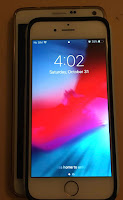A Tribute to the Apple iPhone 6s: My Daily Driver
My Apple iPhone 6s has been a loyal companion, especially throughout the challenges of the COVID-19 pandemic. Its Touch ID feature has become even more valuable during this time, allowing me to unlock my phone quickly and easily.
Design: Timeless Elegance
While the design may feel dated compared to modern smartphones that prioritize full-screen displays with notches or punch-hole cameras, there’s something undeniably elegant about the simple aesthetics of both the iPhone 6s and the Samsung Galaxy Note 4, which debuted around 2014-2015. Despite their age, both phones have held up well, but the iPhone 6s showcases impressive durability and continues to run the latest Apple iOS 14 smoothly.
Display: Samsung Takes the Crown
When it comes to display quality, Samsung consistently excels. The screens on Samsung devices are renowned for their vibrant colors and high resolution, often leading Apple to source its iPhone displays from Samsung. While Apple has been diversifying its suppliers to include LG and others, the overall display quality on the iPhone still lags behind Samsung’s offerings.
Processor: Apple’s Legendary Performance
Apple’s processors are legendary, and the A9 chip in the iPhone 6s is no exception. In initial comparisons, Android phones like the Note 4 performed well; however, as time passes, Android devices often struggle to keep pace. The Note 4 has aged gracefully but still encounters issues with certain apps that run smoothly on the 6s. For less demanding applications, the Note 4 performs adequately, but the performance gap widens with more intensive tasks.
Memory: The Samsung Advantage
Samsung devices typically boast higher RAM capacities, which is essential for competing with iPhones. While this isn’t inherently problematic, it highlights a significant advantage for Samsung: expandable memory through microSD cards. iPhones, on the other hand, are limited to their onboard storage, making it challenging for users who need substantial space. With microSD support, Android users can easily carry 1-2 TB of data, a flexibility that Apple’s ecosystem lacks.
Battery Life: A Surprising Winner
Historically, Android devices struggled with battery life, and the Note 4 is no exception. In contrast, the iPhone 6s, despite having roughly half the battery capacity, often lasts just as long, if not longer. However, with recent advancements in Android technology, newer models have significantly improved in this area. In this particular year, the 6s edges out the competition in battery performance.
Conclusion: A Lasting Legacy
In summary, the iPhone 6s is arguably one of the best phones Apple has ever produced. It may not be the fastest or the most powerful in every category, but it strikes a perfect balance of features, performance, and durability that has made it a favorite for many users. I appreciate both devices—relying on the iPhone 6s as my daily driver while using the Note 4 primarily as my video player. This combination allows me to enjoy the strengths of both ecosystems while keeping up with my everyday needs.
| Specification | iPhone 6s | Samsung Galaxy Note 4 |
|---|---|---|
| Screen | 4.7” (750 × 1334 pixels) ~326 ppi - 60 Hz | 5.7” (1440 × 2560 pixels) ~515 ppi - 60 Hz |
| Processor | A9 (14 nm) | Snapdragon 805 (28 nm) |
| RAM | 2 GB | 3 GB |
| Storage | 32 GB (16 GB base) | 32 GB (expandable via microSD up to 256 GB) |
| Battery | 1715 mAh | 3220 mAh (removable) |
| Camera | 12 MP (rear) | 16 MP (rear), 3.7 MP (front) |
| Weight | 5.04 oz | 6.21 oz |
| Port | Lightning | microUSB |


Comments
Post a Comment